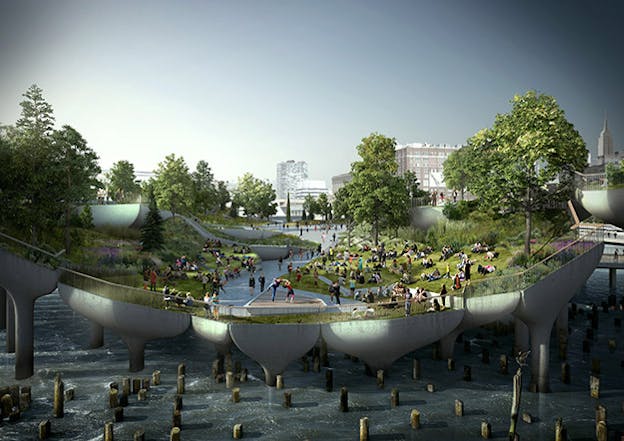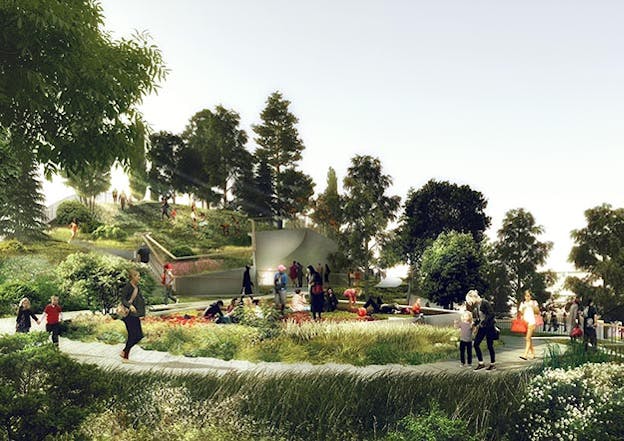It’s no picnic to run a public park these days. Look at Manhattan’s Pier 54. Once the launching point for ocean liners, the pier was incorporated into Hudson River Park in the late ’80s and turned into an event space. But its underwater pilings were rotting, and four years ago it had to be shut down. The Hudson River Park Trust, the public agency that oversees a four-mile stretch of waterfront, had no money for repairs; it receives no public funding for its operations, even though its collection of ballfields, athletic facilities, and footpaths are the go-to recreation space for residents of Manhattan’s West Side. Madelyn Wils, the Trust’s president and CEO, had kept the park’s assortment of piers open largely with private contributions, but she knew Pier 54’s pilings would require a big donation. “I couldn’t get any interest from the state or city,” she lamented. “And there are not a lot of philanthropists out there willing to repair the pilings.”
Wils approached the billionaire Barry Diller, the chairman of IAC. He was an obvious choice: His company’s Frank Gehry-designed headquarters in Chelsea overlooked Hudson River Park, and he and his wife, the fashion designer Diane von Furstenberg, were the largest private benefactors of New York’s much-celebrated High Line, just a couple blocks away. But instead of handing Wils a check, Diller counteroffered: Let him build a completely new park. What was initially a plan for a modest events space ballooned, and pretty soon Diller was offering to bankroll a miniature Central Park on an offshore platform called Pier 55. Designed by a top British architect, Thomas Heatherwick, the $130-million manmade island would be studded with groves of mature trees, walking paths, and three performance spaces. Not only did Diller agree to donate over $100 million for Pier 55’s construction, he promised to fund the maintenance for 20 years and handle all the event bookings.

Given the spectacular green oasis that Heatherwick has conjured up, it may seem petty to look this particular gift horse in the mouth. But the billionaire’s island, as some New Yorkers have called the project, is the latest, most extreme example of how big money and business elites are warping the way America’s urban parks are funded, widening the amenities gap between rich and poor neighborhoods. Until the 1980s, upkeep of America’s urban parks was mainly the responsibility of city parks departments. But as the crises of the 1960s and 1970s hollowed out municipal budgets, public spaces were increasingly neglected. Elegant limestone balustrades crumbled, and graffiti ran wild as kudzu. Urban parks became scary, unsafe places. The deterioration of those public spaces was a big factor in driving people out of American cities.
There is no doubt that the urban comeback that we’ve witnessed over the last decade, especially in cities like Washington, D.C., Philadelphia, Dallas, and New York, has been fueled by the work of independent park managers—private-public partnerships that invite civic and business interests to help manage public spaces. New York’s Central Park Conservancy was the first to demonstrate how an independent manager could transform a no-go zone back into a civilized greensward. The turnaround, which started in 1980, was dramatic, and now cities all over the country are copying the Central Park model. These independent managers, which are seen as more fleet-footed and entrepreneurial than sclerotic city bureaucracies, and more adept at courting wealthy donors, take a multitude of forms. Some are purely citizen-driven, like friends groups and conservancies. Others are run by big institutions and real-estate interests, usually business improvement districts and nonprofit development corporations. Whatever they’re called, independent park managers are now a major economic development force remaking and gentrifying cities. The arrangement almost feels like we’re getting something for nothing. Cities no longer have to dip into their tax revenues for upkeep, yet they retain ownership of the land.
New Yorkers are generally blasé about billionaires showering money on their city, yet many were astonished when Diller and the Trust rolled out a fully formed plan for Pier 55 in November. Public parks, of course, have always relied on the kindness of wealthy patrons. Central Park was originally championed by New York’s nineteenth-century finance barons, whose descendants moved into palatial residences overlooking the treetops. Donors paid for nearly half the cost of building the $490 million Millennium Park in Chicago. Three years ago, a hedge fund manager gave $100 million to Central Park. The difference between that donation and Diller’s is that Central Park is an existing city park, used by millions. Diller’s latest gift underwrites a new park that New York hadn’t intended to build, at least not in so sumptuous a form.

The flip side of such philanthropy has been the starvation of the public sector, which finds it ever harder to raise taxes for urban amenities. “It’s nice that we have all these well-to-do people who want to provide resources. But let’s not forget they have all this extra money because they’re not being taxed as they should,” says Deborah J. Glick, who represents the Chelsea neighborhood in the state assembly, and has been Pier 55’s most vocal critic. Jerold Kayden, a Harvard urban planning professor who studies privately owned public spaces, says we’ve reached a point where philanthropists “can sculpt the city for themselves.”
Meanwhile, New York struggles to maintain hundreds of small, neighborhood parks where kids scramble on playground equipment or shoot hoops on the basketball court. Just a month before the Diller announcement, Mayor Bill de Blasio traveled to one such asphalt playground in Queens to trumpet a new initiative to repair 35 aging parks in New York’s poorest neighborhoods. The total allocation? One hundred-thirty million dollars, the same amount being spent on Diller’s island. Many feel de Blasio’s infusion isn’t nearly enough. A new report by the Trust for Public Land notes that independent managers aren’t an option for poor neighborhoods. They have no rich donors to tap. Hence, the enormous gap in quality between rich and poor city neighborhoods.
Hudson River Park’s funding challenges will be familiar to many cities. Public spending on municipal parks has been stagnant for decades. The operating budget for Philadelphia’s parks system has increased only marginally over the last 30 years. So when Philadelphia wanted to renovate the park right on the doorstep of its magnificent Beaux Arts city hall, it handed over management to a downtown business group. The ’70s-era Dilworth Plaza had gone decades without maintenance. Reeking of urine and carpeted with bird droppings, its largest constituency was unemployed men. The only time it realized its true potential as a town square was when the Phillies won the World Series—and when it became the site of the Occupy protests in 2011. The city was only too happy to outsource the problem to the Center City District, funded by Philadelphia’s corporate elite.
The group gave Dilworth an extravagant $55 million makeover (using significant public funds). Now it is so regularly programmed with corporate-sponsored activities and money-making concessions that there is almost no space to hold a demonstration. When Philadelphians gathered last November to protest the grand jury decision in Ferguson, Missouri, they were funneled into a wedge of space between the new skating rink and the lawn. Chanting was drowned out by a Zamboni that continued to circle the rink. It was almost as if it were designed to forestall another Occupy-style takeover. Yet, except for grumbling from a few pesky design critics, most have raved about the changes, especially the cleanliness and the programmed events.
Still, you can’t deny that these groups have accomplished extraordinary things. Dallas’s popular new Klyde Warren Park, which was built over a freeway canyon separating downtown from a key residential area, has dramatically knit the city back together. The project was conceived and executed by the city’s real estate community, which raised nearly half of the $112 million budget. Because of concerns that it would be seen as a private park, city planners insisted that the design process should engage a cross-section of residents in a meaningful way. The city “was constantly reminding us that this had to be a public park, and not a park built by elites for elites,” said Linda Owen, who helped get the project started and later became president of the Klyde Warren Foundation.
When I happened upon the park at lunchtime on a gorgeous November day, after slogging through Dallas’s eerily empty downtown, I felt as if I had stumbled into a desert oasis. The place was packed with twentysomethings playing volleyball, toddlers grouped around a pop-up library, and art patrons sipping wine at a sleek restaurant pavilion. But the users were overwhelmingly affluent, a mix of office workers and stay-at-home moms, and by 2 p.m. the place had emptied out. It seems to be more of a destination than a neighborhood park.
Kathy Blaha, a parks advocate who advises nonprofits, believes there is a way for cities to avoid a two-tier system of have-and-have-not parks. Instead of creating conservancies for individual parks, it’s time to create citywide conservancies that can raise large sums and distribute them more equitably around the city. These conservancies would act like a centralized clearinghouse and make funding decisions based on need. Just like our parks departments used to do.
